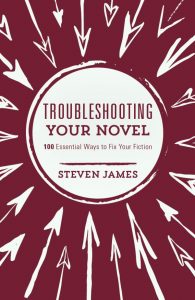Take Five: Steven James and Troubleshooting Your Novel
By Writer Unboxed | September 18, 2016 |
 We’re so glad to tell you about WU contributor Steven James’ new book, Troubleshooting Your Novel, out September 20th! He joins us today for a Take Five interview and to give us an exciting glimpse into his new book.
We’re so glad to tell you about WU contributor Steven James’ new book, Troubleshooting Your Novel, out September 20th! He joins us today for a Take Five interview and to give us an exciting glimpse into his new book.
- Q1: Can you tell us a bit about Troubleshooting Your Novel, and how it’s unique in the market?
Steven: This book focuses specifically on easy-to-use ideas for taking fiction writing to the next level. Most books on the craft of writing target one aspect of story—dialogue, characterization, scene structure, etc.
From the start I wanted Troubleshooting Your Novel to be insanely practical and to help writers at any level improve the entire scope of their story. The eighty short, direct chapters cover every aspect of story development, reader engagement, and narrative techniques. The chapters are packed with dozens of checklists and pullout quotes to help authors quickly pinpoint story problems and solve them without the need for expensive story consultants and editors.
Q2: Why this book, now? Did industry changes affect the way you approached this book?
Steven: You’re absolutely right to point out that the industry is changing.
More and more writers are deciding to self-publish their books. While this shift gives authors more freedom and avenues to get their stories in print, it has also resulted in more manuscripts being published without being carefully edited or proofread.
In their ardor to see their book in print, authors are bypassing publishing companies and, by default, the developmental process that their editorial teams provide. This is resulting in a glut of low cost, low quality books flooding the market.
This hurts all of us.
In a world as full of entertainment choices as ours, if readers pick up books that let them down, eventually the dissatisfaction will turn them off from reading. There are plenty of other ways to imbibe on stories.
However, authors can improve their work themselves.
This book will show them how.
Q3: How does Troubleshooting Your Novel complement your previous book on craft, Story Trumps Structure?
Steven: Story Trumps Structure laid out a new paradigm to fiction writing by focusing more on the narrative movement of the story rather than on formulas and plot outlines. Over the past two years it’s been so encouraging to hear from many authors who’ve felt freed by shaking off the shackles of mechanical writing and have explored the benefits of organic writing and have fallen in love with writing again now that they have set their outlines aside.
However, I understand that all authors approach work differently, so I wanted to provide a resource that would help all authors—whether they want to break the “rules” or keep them, to improve their work.
Both organic writers and outliners will benefit from Troubleshooting Your Novel. Every chapter is like having another set of eyes on your manuscript and it will help you see it in a fresh way, both identifying why something might not be working, and offering specific ways to fix the issues.
Q4: Can you share an excerpt with us?
Steven: Here’s a bit from the chapter on Character Dimensionality:
Readers don’t want to read about nice characters doing nice things. They want to read about conflicted characters doing difficult things.
To really get to know your character, stop asking what she’s like or where she’s from or what she does. Instead ask, “What does she regret? What does she desire? Where does she hurt?”
Your character’s backstory is his résumé of pain—not simply the places he’s worked or gone to school, but the scars he carries and how they continue to affect him. Those elements, not the superficial activities of her past, will lead you (and your readers) to the true essence of your character.
Plumb the depths. Look beneath the surface. Assume that things in her life are not what they appear to be—that there are layers of emotion and defenses that need to be peeled away.
Then get to work removing them.
Let the setbacks sandblast her shiny exterior until her true self is revealed. Here are four ways to get started.
- Turn his inner life against him.
Consider your character’s convictions, secrets, beliefs, and desires. Then, look for ways to pit them against each other and show the relational, emotional and psychological fallout.
- Let the true character emerge.
Show readers all that she can become, but remember that transformations must make sense: remaining believable, logical, and supported by the context. So, if your 250-page story is about how the protagonist was transformed from a mousy, sexually repressed librarian into a self-actualized vixen who hunts down drug lords, you have your work cut out for you.
- Ask follow-up questions.
What is my character searching for that he’s not aware of? Where is he hurting that he hasn’t addressed? What wrongs has he done that he won’t admit?
Explore disillusionment with your protagonist regarding current or past loves. Where did his expectations end up unfulfilled? What does that reveal about him? What does it reveal about his understanding of others?
As you explore your character, move past the obvious into the realm of the struggle or the potential resolution.
- What burdens is he carrying? What’s keeping him from setting them down? How would doing so hurt someone else?
- What wounds linger in her heart? What will it take to heal them? How will she take that first step?
- What dreams is he pursuing? Which ones is he putting off? What would change that?
- What is her fear covering? What setback could I use to scrape it away? How would she respond?
- What is his depression masking? How can I remove it? How will he fight me as I do?
- Root around through the darkness.
Since dimensionality depends on what’s roiling beneath the surface, what emotion does your character work the hardest to repress? What’s lurking down there under her calm exterior?
Choose one of these five emotions: rage, grief, depression, fear, or joy. Your character is repressing it. Think of the power that this repressed emotion has on your character’s inner life, on the way she sees the world, or on her emotional state. What’s keeping that emotion in check? What will cause it to break loose? What will happen when it does?
Q5: What’s next for you?
Steven: I have some exciting new fiction projects I’m working on and I’m planning on spending more time over the next few years teaching fiction writing and giving keynotes at conferences and intensives around the country. I’ve had this burning passion to help other authors raise the bar and pursue their writing goals and now, with more people launching into this on their own, the need for storytelling tools and techniques has never been greater.
This book sounds like a great resource for writers, no? Thank you for joining us today, Steven! TROUBLESHOOTING YOUR NOVEL will be available September 20th on Amazon.










I truly see how weak the first draft of a story I wrote with NaNoWriMo in 2013 is. I’m eager to add Steve James’s craft books to the many I must read and apply to learn the craft. Congratulations, Mr. James, on your newest release.
Your character’s backstory is his resume of pain — what a terrific takeaway! I should put that on the first page of every story I write as a handy reminder.